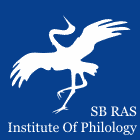 |
|
||||||||||||
|
Institute of Philology of
the Siberian Branch of Russian Academy of Sciences |
|
||||||||||||
|
|||||||||||||
DOI: 10.25205/2307-1737 Roskomnadzor certificate number Эл № ФС 77-84784 | |
| Kritika i Semiotika (Critique and Semiotics) | |
|
Article
Authors: Elena E. Brazgovskaya Russian Christian Academy for Humanities named after Fyodor Dostoevsky, St. Petersburg, Russian Federation
Abstract: In the discourse of modern cognitive-semiotic studies, the concept of semiotic perfection goes far beyond the myth of the language of Adam. In this paper, I present an alternative (in relation to the mystics of the Renaissance) view on this problem. I analyse the system of ideas about the perfect language in the texts of Slavic-language authors of the 20th – 21st centuries (Cz. Miłosz, O. Tokarczuk, S. Lem, M. Paviċ, etc.). The novelty of the work is determined by the understanding of semiotic perfection, where the semiotic optimality of the sign system is opposed to absolute representation. Adamic language is considered as a theoretical construct which is created by the method of possible objects modelling. I show the criteria of semiotics “perfection” of this language: the absence of a “semiotic threshold” between language and the world (language as a “mirror” of reality), a singlevariant substitution of the referent, etc. An analysis of these criteria within the framework of the pragmatics allows concluding that the language of Adam is a “linguistic nonsense”. The representative capabilities of the Adamic language contradict the development of forms of human thinking and culture as such. An analysis of the representative potential of the current state of verbal systems leads to the next conclusion: those attributes of natural languages that, at first glance, indicate their semiotic “insufficiency”, turn out to be evidence of their semiotic perfection. Among the parameters of semiotic optimality: the probabilistic nature of language, its creative potential, complementarity of verbal and non-verbal systems, the phenomenon of “extended consciousness”. The ideal of sign representation was not lost after Babylon: the history of culture is the history of the improvement of language tools. Keywords: semiotic perfection, Adamic language, representation, semiotic optimality Bibliography: Brazgovskaya E. E. In the Labyrinths of Semiotics: Essays and Studies on General Semiotics and Semiotics of Art. Moscow; Ekaterinburg: Kabinetnyi uchenyi Publ., 2018, 224 p. (in Russ.) Brazgovskaya E. E. Semiotic “perfection”: from mythologies to reality. In: Semiozis i kultura: strategii i praktiki mezhkulturnogo dialoga: kollektivnaya monografiya. Syktyvkar: Sorokin SSU Press, 2024, pp. 39–54. (in Russ.) Brown S. M. The Language of Heaven: Prolegomenon to the Study of Smithian Translation. Journal of Mormon History, 2012, no. 38 (3), pp. 51–71. Carapezza M., D’Agostino M. Logic and the Myth of the Perfect Language. Logic & Philosophy of Science, 2010, no. 8 (1), pp. 1–29. Chemero A. Radical embodied cognitive science. Cambridge, London, MA, MIT Press, 2011, 279 p. Chomsky N. About nature and language. Moscow, KomKniga Publ., 2005, 288 p. (in Russ.) Clark A. Supersizing the mind: Embodiment, action, and cognitive exten-sion. Oxford; N. Y., Oxford Uni. Press, 2008, 286 p. Eco U. On the Possibility of Creating Aesthetic Messages in the Language of Eden. In: Eco U. The Role of the Reader. Studies in the Semiotics of the Text. St. Petersburg: Symposium Publ., 2005, pp. 155–175. (in Russ.) Eco U. The Search for the Perfect Language in European Culture. St. Peters-burg, Alexandria Publ., 2007, 423 p. (in Russ.) Eco U. History of Illusions. Legendary Places, Lands and Countries. Mos-cow, Slovo Publ., 2019, 480 p. (in Russ.) Foucault M. Words and Things: Archaeology of the Humanities. St. Peters-burg, A-cad Publ., 1994, 406 p. (in Russ.) Hamaher V. Minima philologica. St. Petersburg, Ivan Limbakh Publ., 2020, 216 p. (in Russ.) Karabykov A. V. The Renaissance Dream: The Language of Adam in Eu-ropean Culture of the 15th – 17th Centuries. St. Petersburg, RHGA Press, 2022, 215 p. (in Russ.) Kołakowski L. Jeśli Boga nie ma… Horror Metaphysicus. Transl. from Eng. by T. Baszniak, M. Panufnik. Poznań, Zysk Publ., 1999, 288p. (in Pol.) Leonard J. Naming in Paradise: Milton and the Language of Adam and Eve. Oxford, Clarendon, 1990, 304 p. Libera A. de. Medieval thinking. Moscow, Praksis Publ., 2004. 368 p. (in Russ.) Mendelsun P. What do We See When We Read: A Phenomenological Study with illustrations. Moscow, Corpus Publ., 2016, 448 p. (in Russ.) Rorty R. Nineteenth-Century Idealism and Twentieth-Century Textualism. In: Rorty R. Consequence of Pragmatism (Essays 1972–1980). Minneapolis, Uni. of Minnesota Press, 1982. pp. 139–160. Rowlands M. J. The New Science of the Mind: From Extended Mind to Em-bodied Phenomenology. Cambridge, London, MA, MIT Press, 2010, 269 р. Steiner D. After the Babylonian Confusion. Issues of language and transla-tion. Moscow, MCNMO Publ., 2020, 645 p. (in Russ.) Tarsky A. The concept of truth in the languages of deductive sciences. In: Philosophy and logic of the Lvov-Warsaw school. Moscow, ROSPEN Publ., 1999, pp. 14–177. (in Russ.) Vdovina G. V. Chimeras in the forests of scholasticism. Ens rationis and ob-jective being. St. Petersburg, Hercen RSPU Press, 2021, 440 p. (in Russ.) Worth S. Pictures Can’t Say Ain’t. In: Worth S. Studying Visual Communi-cation. Philadelphia, Uni. of Pennsylvania Press, 1981, pp. 162–185. Zhilson E. Philosophy in the Middle Ages: From the Origins of Patristics to the End of the Fourteenth Century. Moscow, Respublika Publ., 2004, 678 p. (in Russ.) Zinchenko V. P. Consciousness and the creative act. Moscow, Yazyki slavyanskikh kultur Publ., 2010, 592 p. (in Russ.) |
 |
Institute of Philology Nikolaeva st., 8, Novosibirsk, 630090, Russian Federation +7-383-330-15-18, ifl@philology.nsc.ru |
© Institute of Philology |


